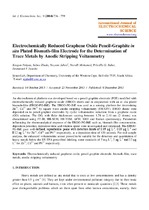Electrochemically reduced graphene oxide pencil-graphite in situ plated bismuth-film electrode for the determination of trace metals by anodic stripping voltammetry
Date
2014Author
Pokpas, Keagan
Zbeda, Salma
Jahed, Nazeem
Mohamed, Nuralli
Baker, Priscilla
Iwuoha, Emmanuel I.
Metadata
Show full item recordAbstract
An electrochemical platform was developed based on a pencil-graphite electrode (PGE) modified with electrochemically reduced graphene oxide (ERGO) sheets and in conjunction with an in situ plated bismuth-film (ERGO-PG-BiE). The ERGO-PG-BiE was used as a sensing platform for determining Zn2+, Cd2+ and Pb2+ by square wave anodic stripping voltammetry (SWASV). ERGO sheets were deposited on to pencil-graphite electrodes by cyclic voltammetric reduction from a graphene oxide (GO) solution. The GO, with flake thicknesses varying between 1.78 to 2.10 nm (2 sheets) was characterized using FT-IR, HR-SEM, HR-TEM, AFM, XRD and Raman spectroscopy. Parameters influencing the electroanalytical response of the ERGO-PG-BiE such as, bismuth-film concentration, deposition potential, deposition time and rotation speed were investigated and optimized. The ERGO-PG-BiE gave well-defined, reproducible peaks with detection limits of 0.19 μg L-1, 0.09 μg L-1 and 0.12 μg L-1 for Zn2+, Cd2+ and Pb2+ respectively, at a deposition time of 120 seconds. For real sample analysis, the enhanced voltammetric sensor proved to be suitable for the detection and quantitation of heavy metals below the US EPA prescribed drinking water standards of 5 mg L-1, 5 μg L-1 and 15 μg L-1 for Zn2+, Cd2+ and Pb2+ respectively.

